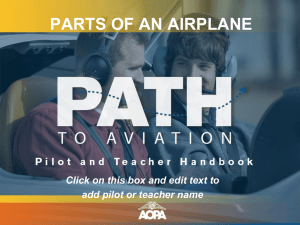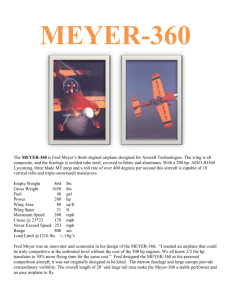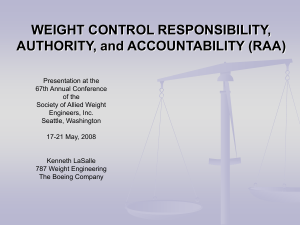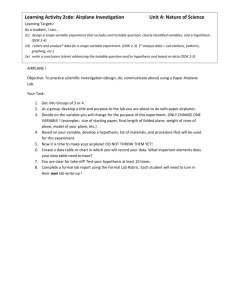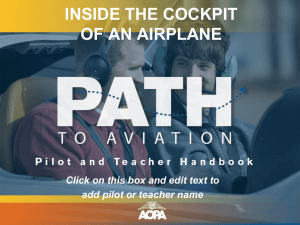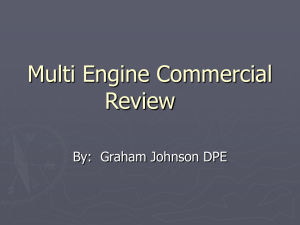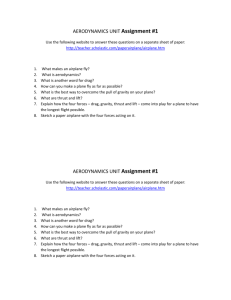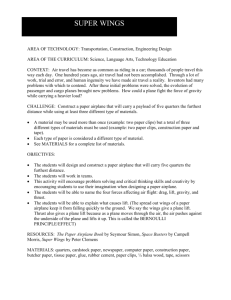Airplane Research Worksheet: Answers
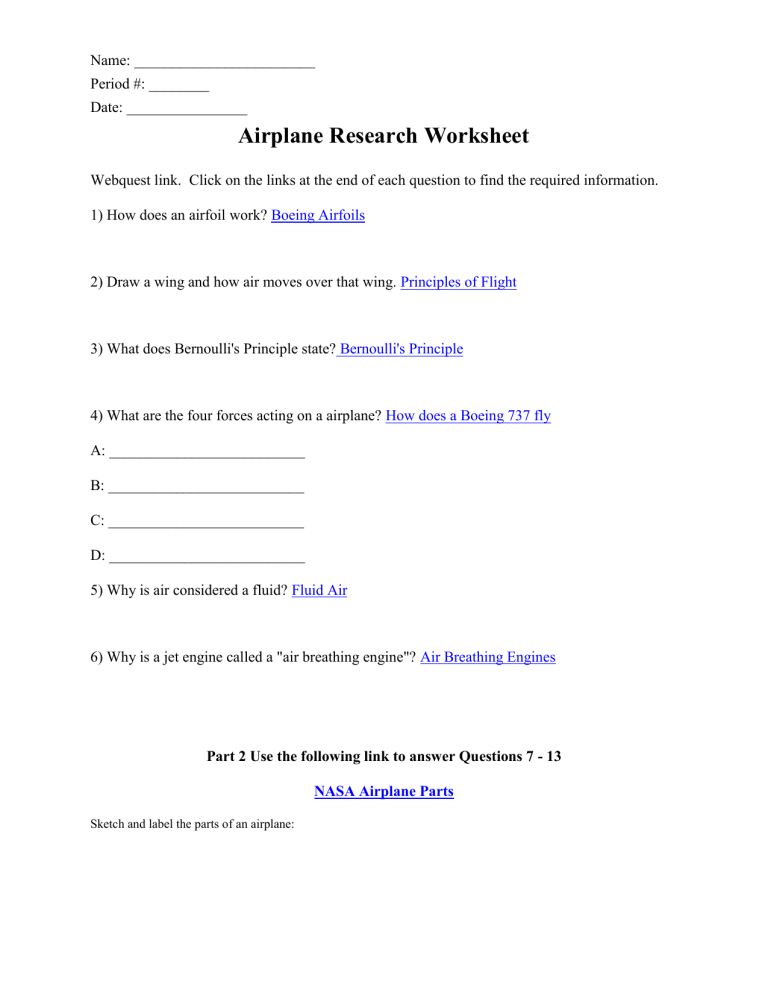
Name: ________________________
Period #: ________
Date: ________________
Airplane Research Worksheet
Webquest link. Click on the links at the end of each question to find the required information.
1) How does an airfoil work? Boeing Airfoils
2) Draw a wing and how air moves over that wing. Principles of Flight
3) What does Bernoulli's Principle state?
Bernoulli's Principle
4) What are the four forces acting on a airplane? How does a Boeing 737 fly
A: __________________________
B: __________________________
C: __________________________
D: __________________________
5) Why is air considered a fluid? Fluid Air
6) Why is a jet engine called a "air breathing engine"? Air Breathing Engines
Part 2 Use the following link to answer Questions 7 - 13
NASA Airplane Parts
Sketch and label the parts of an airplane:
7. The ___________________are control surfaces located at the back of the wings. When they are moved in opposite directions, they control turns and rolling maneuvers of the airplane. (roll)
8. The __________________________ are control surfaces attached to the tail to control the up and down movement of the airplane. (pitch)
9. The __________________ are moveable airfoils on the edge of the wings that are used to increase lift at slower speeds.
10. The ____________________________ is an airfoil located at the front of or on the wings of a plane. Propellers are powered by an engine and create thrust.
11. The _____________________ is attached to the tail’s fin and allows the pilot to control the right and left motion of the airplane. (yaw)
12. The __________________________ are airfoils attached to the fuselage that lets the airplane create lift.
13. The __________________________ is the body of the airplane.
Part 3
14. Who was the first man to "fly" the first powered, controlled, hesavier than air plane? Flight
15. In what town did Orville and Wilbur Wright first take flight? Powered Flight
16. What happened in 1908-1909 that gained Orville and Wilbur Wright international attention?
Powered Flight
17. What was the name of the first experimental aircraft to reach speeds greater than Mach 1?
Experimental Aircraft
18. How fast is Mach 1 at sea level? Aeronautics Vocab
Name: ________________________
Period #: ________
Date: ________________
Airplane Research Worksheet: Answers
Webquest link. Click on the links at the end of each question to find the required information.
1) How does an airfoil work? Boeing Airfoils
Answer:
An airplane wing has a special shape called an airfoil.
As a wing moves through air, the air is split and passes above and below the wing. The wing’s upper surface is shaped so the air rushing over the top speeds up and stretches out. This decreases the air pressure above the wing. The air flowing below the wing moves in a straighter line, so its speed and air pressure remain the same.
Since high air pressure always moves toward low air pressure, the air below the wing pushes upward toward the air above the wing. The wing is in the middle, and the whole wing is “lifted.”
The faster an airplane moves, the more lift there is. And when the force of lift is greater than the force of gravity, the airplane is able to fly.
2) Draw a wing and how air moves over that wing. Principles of Flight
3) What does Bernoulli's Principle state?
Bernoulli's Principle
Answer: An airfoil uses Bernoulli's Principal to create lift. This principal states as speed of the air increases the pressure decreases. If you have noticed, an airfoil has a special shape to it. The upper part of the shape is curved instead of flat. This curve increases the surface distance on top of the shape from front to back. When this foil travels air passes over the top and the bottom. The air when it travels over the top has more of a distance to travel, then the air on the bottom. For this reason the air on the top travels faster to "catch up" to the air on the bottom. According to Bernoulli's Principal as air "speeds up" the pressure decreases. Now we got a low pressure area on top and a relatively high pressure area in the bottom. In effect the area on the bottom pushes up and creates lift.
4) What are the four forces acting on a airplane? How does a Boeing 737 fly
Four forces push and pull an airplane in flight. The wings act as an airfoil and produce an upward force called lift. The opposite of lift is the force of gravity, which pulls the aircraft downward. A force called drag, caused by air resistance, slows an airplane down. To fight drag, an airplane uses a propeller or jet engine to produce a forward force called thrust.
A: Lift
B: Gravity
C: Drag
D: Thrust
5) Why is air considered a fluid? Fluid Air
Answer: Most likely because it flows, and takes the shape of it's container. Like how the plane flies, with air flowing over the wings! If there's anyone out there in 6th grade and you're looking for information on this, then here you go!
6) Why is a jet engine called an "air breathing engine"? Air Breathing Engines
Answer: An airbreathing jet engine (or ducted jet engine) is a jet engine propelled by a jet of hot exhaust gases formed from air that is drawn into the engine via an inlet duct.
Part 2 Use the following link to answer Questions 7 - 13
NASA Airplane Parts
Sketch and label the parts of an airplane:
7. The _____ailerons_____ are control surfaces located at the back of the wings. When they are moved in opposite directions, they control turns and rolling maneuvers of the airplane. (roll)
8. The ______Elevators______ are control surfaces attached to the tail to control the up and down movement of the airplane. (pitch)
9. The ________slats and flaps_________ are moveable airfoils on the edge of the wings that are used to increase lift at slower speeds.
10. The ___turbine engine____ is an airfoil located at the front of or on the wings of a plane.
Propellers are powered by an engine and create thrust.
11. The ______rudder________ is attached to the tail’s fin and allows the pilot to control the right and left motion of the airplane. (yaw)
12. The ___wings_______ are airfoils attached to the fuselage that lets the airplane create lift.
13. The ____fuselage______ is the body of the airplane.
Part 3
14. Who was the first man to "fly" the first powered, controlled, heavier-than-air plane? Flight
Answer: 1903 would become a year for the history books. That year the Wright brothers,
Orville and Wilbur Wright , would fly the first powered, controlled, heavier-than-air
airplane
15. In what town did Orville and Wilbur Wright first take flight? Powered Flight
Answer: Kitty Hawk, North Carolina on December 17, 1903.
16. What happened in 1908-1909 that gained Orville and Wilbur Wright international attention?
Powered Flight
Answer: By 1908 and 1909, Wilbur Wright was gaining international attention for the brothers' designs by setting aeronautical records in France. He also sought newspaper coverage by flying around the Statue of Liberty and then flying along the Hudson River.
Throughout this time period, the Wright brothers were continuing to develop new advances in aeronautical design.
17. What was the name of the first experimental aircraft to reach speeds greater than Mach 1?
Experimental Aircraft
Answer: The first flight at faster than the speed of sound occurred on 14 October 1947. The aircraft was the Bell X-1 and the pilot was Captain Charles Yeager.
18. How fast is Mach 1 at sea level? Aeronautics Vocab
Answer: At sea level, the speed of sound is about 761 miles per hour (1,225 kilometers per hour).
